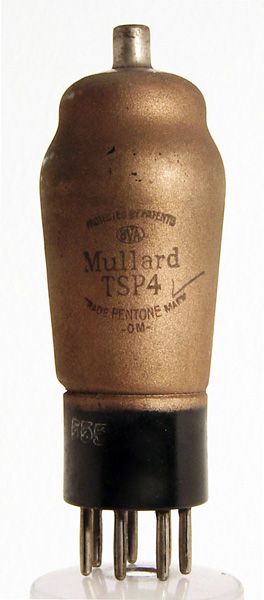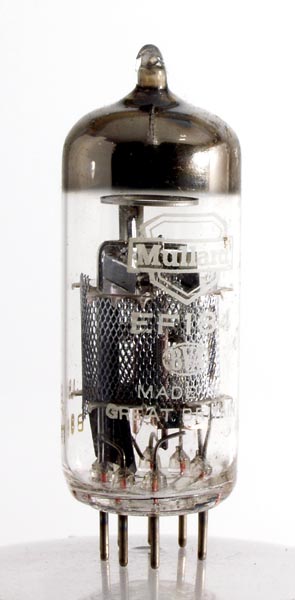|
 
The TSP4 and EF184 - 20 years of development
In November 1936 the BBC began the world's first public television transmission from Alexandra Palace in North London. The sound carrier was at 41 MHz and the vision carrier was at 45 MHz. These were difficult high frequencies for valve circuits to operate at in 1936 and the problem was compounded by the signal bandwidth needing to be 3 MHz wide for a 405 line picture.
Valves in the mid 1930s provided adequate gain at the top of the broadcast shortwave bands at 30 MHz. Above 30 MHz the gain of RF pentodes began to fall sharply. The two main factors for the fall off in performance were: the inductance and capacitance of the long leads from the electrodes, via the pinch and base, to the rest of the circuit, and the finite time the electrons took travelling across the valve.
At shortwave frequencies ie well below 30 MHz the transit time of one nanosecond between the cathode and control grid was of no consequence as it was small compared to the time of one cycle of the input frequency. As the frequency increased the transit time became a significant percentage of the whole cycle. This was shown to have the effect of reducing the input impedance of the valve at higher frequencies. The final consequence was a loss of gain, and without gain the design was useless.
Research by RCA in America on reducing the physical dimensions of the valve resulted in the design of the Acorn valves but these required highly skilled assembly and were not successfully produced in quantity in the UK.
The pentodes available in the mid 1930s were unable to produce useful gain in wideband circuits at 45 MHz and thus the design of receivers for television was difficult and expensive. Manufactures took up the challenge of reducing transit time and the effects of lead inductance and capacitance. The first designs to appear included the Mullard TSP4 and the M-OV MSP41. Both were introduced in 1936 and early TV receivers used one or the other. In 1937 Cossor introduced the 42MPT and Mazda produced the AC/SP3.
Developments continued and in the period 1938-9 the following valves were introduced. Mazda SP41 and SP42. M-OV KTZ41 and Z62. Mullard EE50 and EF50. The EE50 was, we believe, expensive to produce but the later EF50 set a new standard and became the industry workhorse. From the Radar 45 MHz Pye IF strip during WWII to the RF and IF circuits of Band I television of the early post war era it was made and used in vast quantities.
The 1938 Philips development of the hard glass base foot that was moulded around the hard leadout wires/base pins moved valve production away from the legacy of the lamp industry eg the stem and pinch. RCA had pioneered the pressed glass disk for leadout wires with the 1935 metal valves, but the leads were inserted into the base pins of the International Octal base and soldered into position.
In 1940 Mullard produced an aligned grid version of the EF50. The alignment of the grids reduced partition noise. Other features were higher mutual conductance and the use of four connections from the cathode to base pins. The latter feature further reduced lead inductance. This valve was introduced as the RL7 or VR136 (later CV1136) and post war was given the commercial designation of EF54.
In the late 1940s the EF50 and derivatives were superseded by the EF91 and EF80. The EF50 had an input impedance of 5 k Ohms and a gm figure of 6.5 mA/Volt. The EF91 had an input impedance of 8 k Ohms and a gm figure of 7.6 mA/Volt. The EF80 had an input impedance of 12 k Ohms and a gm figure of 7.4 mA/Volt. These improvements in input impedance were the result of reduced inter electrode capacitance, shorter lead lengths and the higher mutual conductance that reduced cathode to control grid spacing made possible. The final valve in this series of developments was the EF184 which took over from the EF80. The EF184 employs a frame grid where the grid wire is wound under tension (about 50% of its breaking strain) this better control of grid stability together with a polished cathode allowed a gm value of 15.6 to be achieved in a production device.
In 1955 the arrival of Independent Television (ITV) transmitting in Band III (approx 175 MHz) saw a change away from pentode RF amplifiers. At these frequencies the triode operating in grounded grid configuration became the normal practice and the IF amplifier used pentodes such as the EF184 at 33 MHz.
|